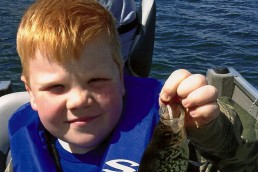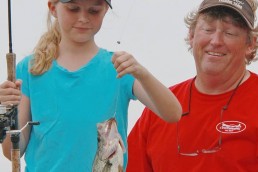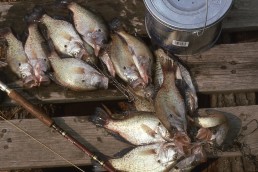There is a Lot to Love about Spring Crappies
SHARE THIS POST
We stopped at the gas station so Scott could get his 9-year-old son Austin a bottle of Gatorade to take in the boat.
I looked over my shoulder to ask Austin what his favorite fish was.
“Crappies,” he said.
“Why?” I asked.
“Because I love them,” he said.
There is a lot to love about crappies, especially in the spring.
We are nearing the beginning of the regular fishing season when bass, walleyes and northern pike become legal to fish for. There isn’t a lot of other fishing available, but it is the perfect time for crappie fishing. Now is the time when crappies are beginning to move into the shallows, getting ready to spawn as the water in the bays is beginning to warm up.
The day is fairly mild with a slight wind ruffling the water. Scott Clark, of Hudson, and Austin and I are fishing a Polk County lake in northwestern Wisconsin. We motor away from the landing, run halfway down the lake and pull into a large bay. I pull back on the throttle of the motor and we slowly move to the back of the bay.
Dropping the anchor, Scott sets Austin up with a hook-and-crappie minnow 3 feet below a float. We are in about 6 feet of water in front of a now dormant mass of lily pads, still brown from the winter. Scott and I are fishing small tube jigs.
In the next 20 minutes, we catch three or four crappies and a couple of bluegills. Fishing seems slow when Scott suggests we move out a bit into deeper water. We pull up anchor and move out another 30 yards and into 10 feet of water.
On my first cast, I feel a slight bump on my bait and pull back to set the hook—I feel a fish take off. My ultra-light spinning rod is bent in half and the rod tip is plunging as this fish fights back.
A moment or two later, and it’s now splashing next to the boat. I then hoist in the 10-inch crappie. A couple casts later, I have yet another crappie.
Are you enjoying this post?
You can be among the first to get the latest info on where to go, what to use and how to use it!
Scott and I are steadily getting strikes, but surprisingly, Austin wasn’t having much luck with his crappie minnows. I felt weight on my line and set the hook to have another crappie racing off. I then handed the rod to Austin.
He started cranking on the reel and the rod was bouncing. He had a look of determination on his face as he had his first crappie alongside the boat.
We then switched Austin to tube jigs and now he too was getting strikes, and catching crappies. Often, two of us, and sometimes all three, would have a fish on at the same time. These crappies were hitting fast and furious.
Crappie fishing is one of the true joys of spring as in April they begin to move into shallow water, usually in bays out of the wind as the sun heats the water. Many times they’re found in large schools, as they are getting ready to spawn within the next month. During this time they’ll be feeding aggressively.
Water depth can be important in trying to locate the actively feeding schools. Although they’re found in shallow water, the term “shallow” is a relative one. The day Scott, Austin and I were fishing we slightly adjusted our position to find the best spot. And moving from 6 to 10 feet in depth made all the difference. A couple of feet of change in the water depth will also affect the temperature of the water. So, you may need to move around a little to find the ideal depth and water temperature these fish are hitting at.
Any bait will work well for spring crappies, but one of the most popular is the crappie minnow. I use a light hook with small split shot normally placed 3 or 4 feet under a float. The 3-4 feet is a good length to start with, but if you aren’t getting strikes it pays to experiment with longer or shorter line under the bobber. Remember, the early-season crappies can be finicky now.
Although most cast out, letting the wind drift the float can help to just slowly reel the bait back in and by taking a crank or two on the reel, stopping for a moment, and then one or two and reels again. If the fish are holding tight to an area, this will help to find where they’re concentrated.
For floats, I prefer thin balsa because they’re more sensitive, which can be critical if crappies are hitting lightly. I also like to use the ones with a small lead ring around the float that makes it easier to cast with greater distance, especially in the wind without throwing off the delicate crappie minnows.
The other baits that work well in spring are jigs. I prefer tube jigs in 1/32 or 1/16 ounce. Color doesn’t seem to matter to early-spring crappies, but I normally use either black with a chartreuse tail or red with a chartreuse tail. I just cast tube jigs out, bring them back with either a slow, steady retrieve, or bounce the jig back with slight movement of the rod tip. Although both retrieves work, sometimes it’s worthwhile to try them both to see which one is the most productive.
Scott, Austin and I fished for about three hours that spring afternoon and had caught and released about 100 crappies. It was a great day of fishing, and it we had wanted to we could’ve had a fish fry that evening. And nothing says “spring” better than a meal of fresh-caught crappies.
Yes, Austin—you are right. There is a lot to love about crappies.
MWO
SHARE THIS POST
Did you enjoy this post?
You can be among the first to get the latest info on where to go, what to use and how to use it!
Mike Yurk
Mike Yurk grew up in Oshkosh, Wis., where he first started writing about the outdoors. A retired Army officer, he is now a full-time, freelance outdoor writer. He has written more than 1000 articles for outdoor publications and published 12 books on outdoor sports. He lives in northwestern Wisconsin where he has found some of the best bass fishing in the country.



